Abstract
To clarify the independent relationships of obesity and overweight to cardiovascular disease risk factors and sex steroid levels, three age-matched groups of men were studied: (i) 8 normal weight men, less than 15% body fat, by hydrostatic weighing; (ii) 16 overweight, obese men, greater than 25% body fat and 135-160% of ideal body weight (IBW); and (iii) 8 overweight, lean men, 135-160% IBW, but less than 15% fat. Diastolic blood pressure was significantly greater for the obese (mean +/- SEM, 82 +/- 2 mmHg) than the normal (71 +/- 2) and overweight lean (72 +/- 2) groups, as were low density lipoprotein levels (131 +/- 9 vs. 98 + 11 and 98 + 14 mg/dl), the ratio of high density lipoprotein to total cholesterol (0.207 +/- 0.01 vs. 0.308 +/- 0.03 and 0.302 +/- 0.03), fasting plasma insulin (22 +/- 3 vs. 12 +/- 1 and 13 +/- 2 microU/ml), and the estradiol/testosterone ratio (0.076 +/- 0.01 vs. 0.042 +/- 0.02 and 0.052 +/- 0.02); P less than 0.05. Estradiol was 25% greater for the overweight lean group (40 +/- 5 pg/ml) than the obese (30 +/- 3 pg/ml) and normal groups (29 +/- 2 pg/ml), P = 0.08, whereas total testosterone was significantly lower in the obese (499 +/- 33 ng/dl) compared with the normal and overweight, lean groups (759 +/- 98 and 797 +/- 82 ng/dl). Estradiol was uncorrelated with risk factors and the estradiol/testosterone ratio appeared to be a function of the reduced testosterone levels in obesity, not independently correlated with lipid levels after adjustment for body fat content. Furthermore, no risk factors were significantly different between the normal and overweight lean groups. We conclude that (a) body composition, rather than body weight per se, is associated with increased cardiovascular disease risk factors; and (b) sex steroid alterations are related to body composition and are not an independent cardiovascular disease risk factor.
Full text
PDF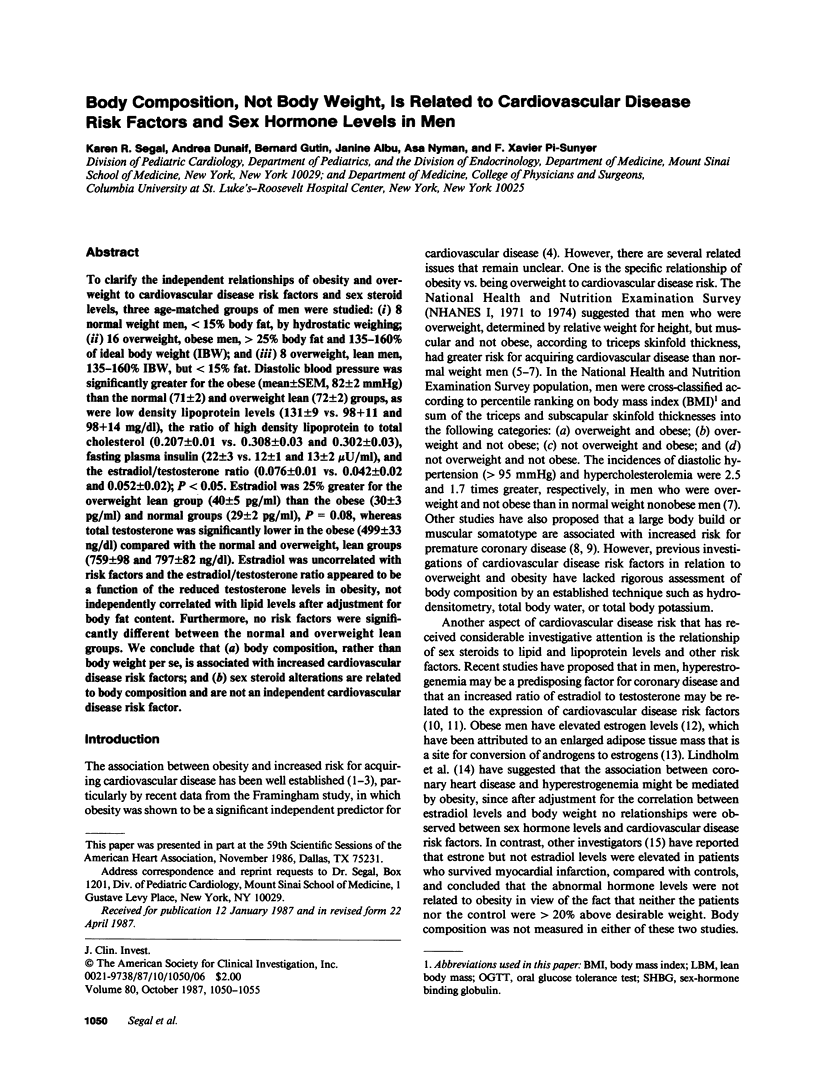
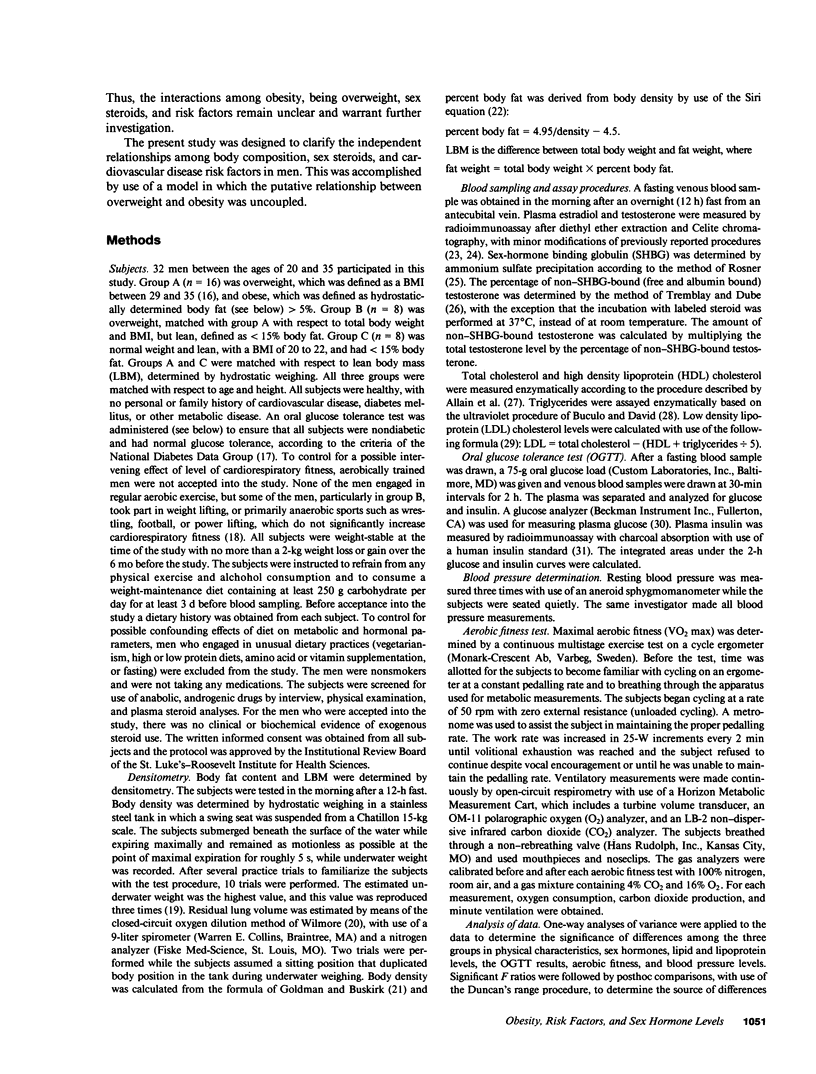
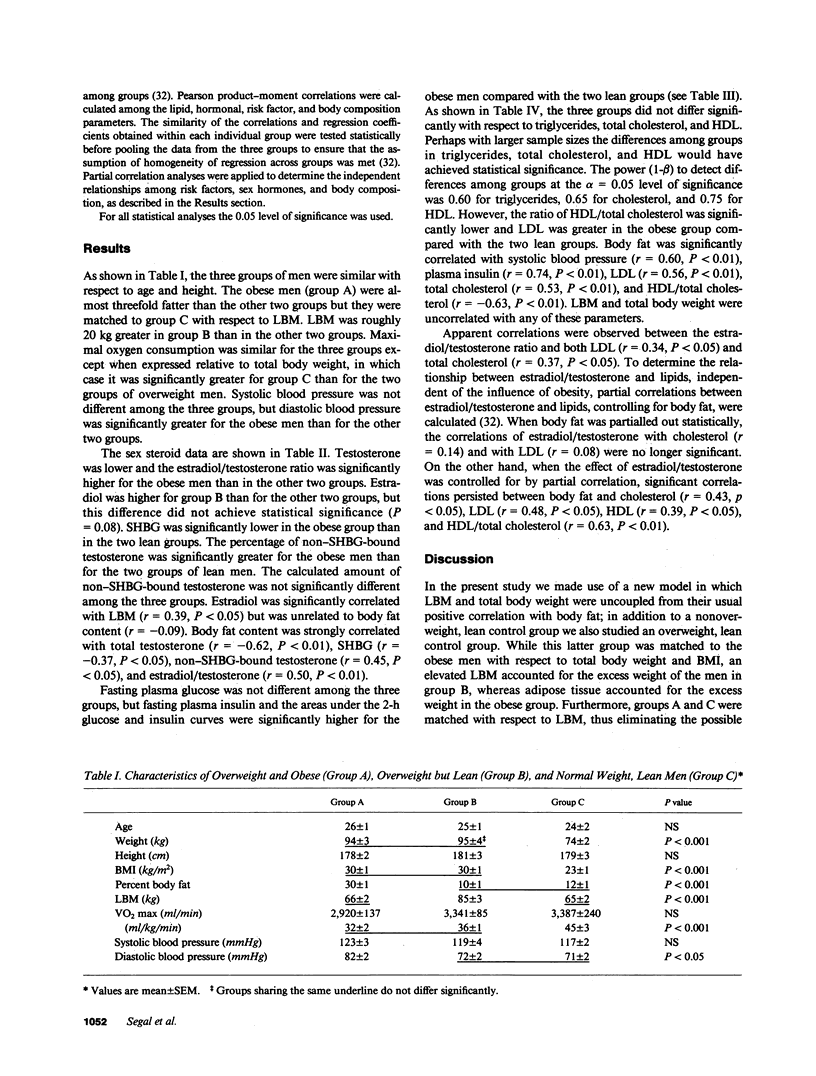
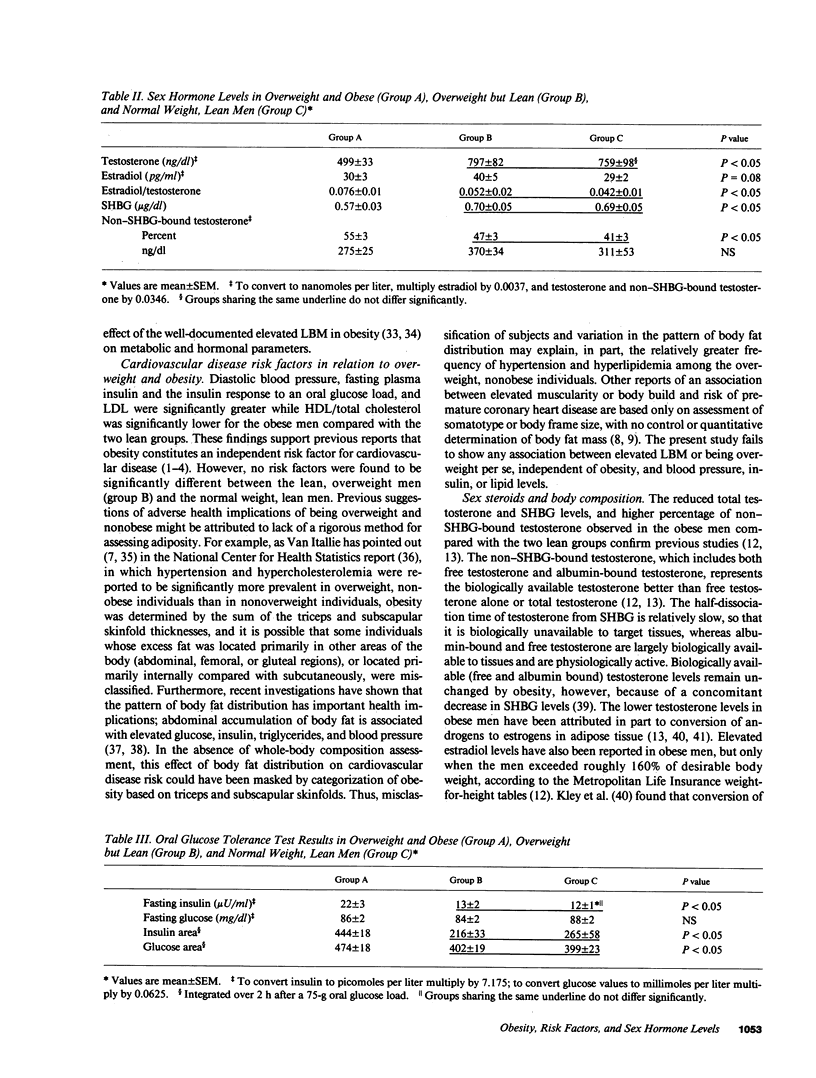
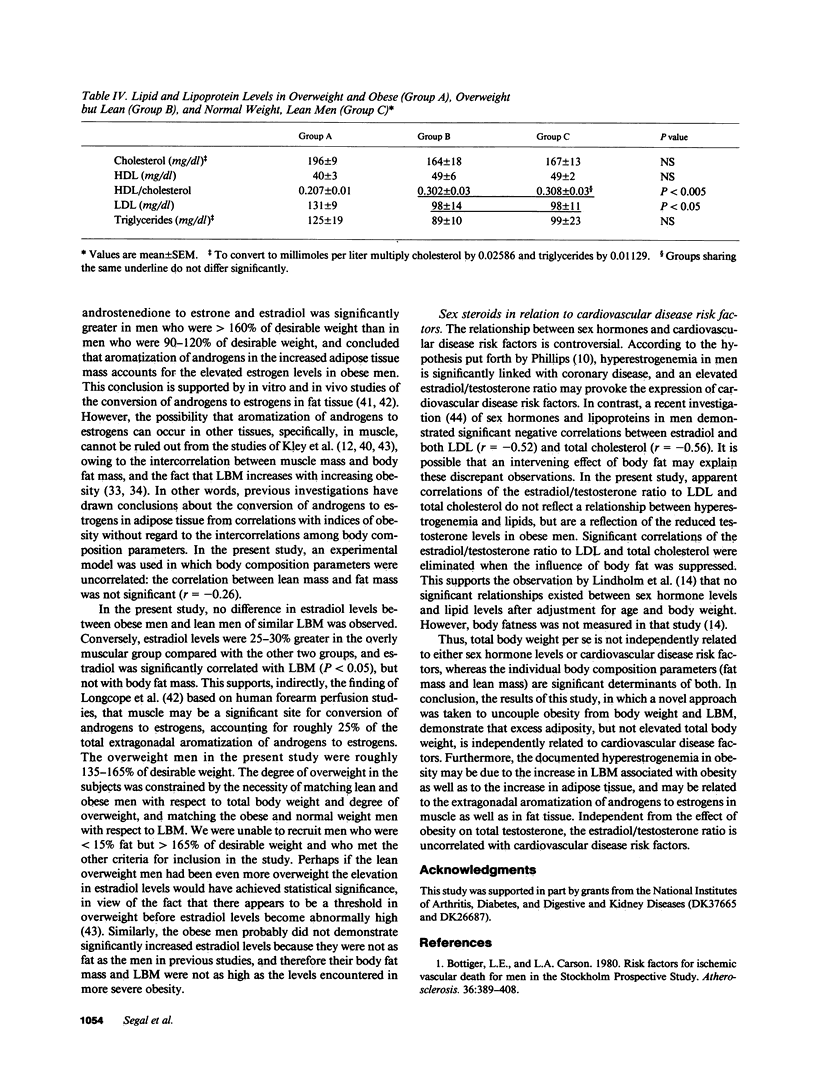
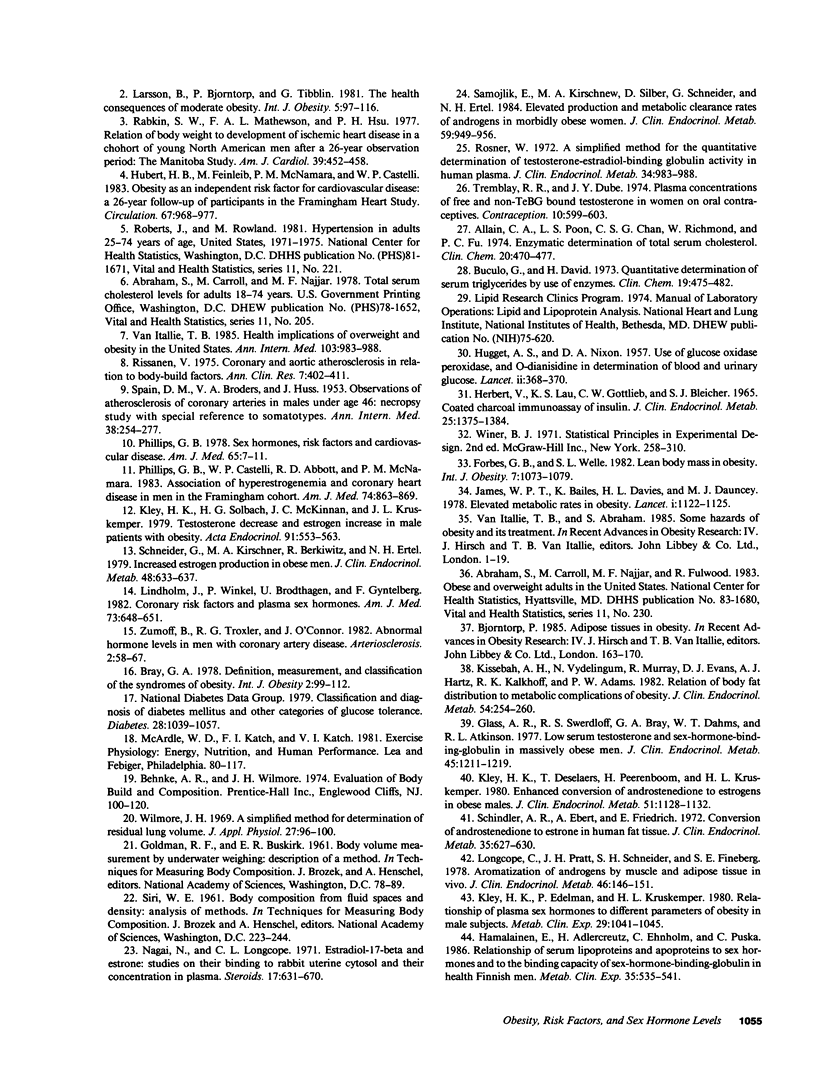
Selected References
These references are in PubMed. This may not be the complete list of references from this article.
- Allain C. C., Poon L. S., Chan C. S., Richmond W., Fu P. C. Enzymatic determination of total serum cholesterol. Clin Chem. 1974 Apr;20(4):470–475. [PubMed] [Google Scholar]
- Bray G. A. Definition, measurement, and classification of the syndromes of obesity. Int J Obes. 1978;2(2):99–112. [PubMed] [Google Scholar]
- Bucolo G., David H. Quantitative determination of serum triglycerides by the use of enzymes. Clin Chem. 1973 May;19(5):476–482. [PubMed] [Google Scholar]
- Glass A. R., Swerdloff R. S., Bray G. A., Dahms W. T., Atkinson R. L. Low serum testosterone and sex-hormone-binding-globulin in massively obese men. J Clin Endocrinol Metab. 1977 Dec;45(6):1211–1219. doi: 10.1210/jcem-45-6-1211. [DOI] [PubMed] [Google Scholar]
- HUGGETT A. S., NIXON D. A. Use of glucose oxidase, peroxidase, and O-dianisidine in determination of blood and urinary glucose. Lancet. 1957 Aug 24;273(6991):368–370. doi: 10.1016/s0140-6736(57)92595-3. [DOI] [PubMed] [Google Scholar]
- Herbert V., Lau K. S., Gottlieb C. W., Bleicher S. J. Coated charcoal immunoassay of insulin. J Clin Endocrinol Metab. 1965 Oct;25(10):1375–1384. doi: 10.1210/jcem-25-10-1375. [DOI] [PubMed] [Google Scholar]
- Hubert H. B., Feinleib M., McNamara P. M., Castelli W. P. Obesity as an independent risk factor for cardiovascular disease: a 26-year follow-up of participants in the Framingham Heart Study. Circulation. 1983 May;67(5):968–977. doi: 10.1161/01.cir.67.5.968. [DOI] [PubMed] [Google Scholar]
- Hämäläinen E., Adlercreutz H., Ehnholm C., Puska P. Relationships of serum lipoproteins and apoproteins to sex hormones and to the binding capacity of sex hormone binding globulin in healthy Finnish men. Metabolism. 1986 Jun;35(6):535–541. doi: 10.1016/0026-0495(86)90011-9. [DOI] [PubMed] [Google Scholar]
- James W. P., Davies H. L., Bailes J., Dauncey M. J. Elevated metabolic rates in obesity. Lancet. 1978 May 27;1(8074):1122–1125. doi: 10.1016/s0140-6736(78)90300-8. [DOI] [PubMed] [Google Scholar]
- Kissebah A. H., Vydelingum N., Murray R., Evans D. J., Hartz A. J., Kalkhoff R. K., Adams P. W. Relation of body fat distribution to metabolic complications of obesity. J Clin Endocrinol Metab. 1982 Feb;54(2):254–260. doi: 10.1210/jcem-54-2-254. [DOI] [PubMed] [Google Scholar]
- Kley H. K., Deselaers T., Peerenboom H., Krüskemper H. L. Enhanced conversion of androstenedione to estrogens in obese males. J Clin Endocrinol Metab. 1980 Nov;51(5):1128–1132. doi: 10.1210/jcem-51-5-1128. [DOI] [PubMed] [Google Scholar]
- Kley H. K., Edelmann P., Krüskemper H. L. Relationship of plasma sex hormones to different parameters of obesity in male subjects. Metabolism. 1980 Oct;29(11):1041–1045. doi: 10.1016/0026-0495(80)90214-0. [DOI] [PubMed] [Google Scholar]
- Kley H. K., Solbach H. G., McKinnan J. C., Krüskemper H. L. Testosterone decrease and oestrogen increase in male patients with obesity. Acta Endocrinol (Copenh) 1979 Jul;91(3):553–563. doi: 10.1530/acta.0.0910553. [DOI] [PubMed] [Google Scholar]
- Larsson B., Björntorp P., Tibblin G. The health consequences of moderate obesity. Int J Obes. 1981;5(2):97–116. [PubMed] [Google Scholar]
- Lindholm J., Winkel P., Brodthagen U., Gyntelberg F. Coronary risk factors and plasma sex hormones. Am J Med. 1982 Nov;73(5):648–651. doi: 10.1016/0002-9343(82)90405-3. [DOI] [PubMed] [Google Scholar]
- Longcope C., Pratt J. H., Schneider S. H., Fineberg S. E. Aromatization of androgens by muscle and adipose tissue in vivo. J Clin Endocrinol Metab. 1978 Jan;46(1):146–152. doi: 10.1210/jcem-46-1-146. [DOI] [PubMed] [Google Scholar]
- Nagai N., Longcope C. Estradiol-17-beta and estrone: studies on their binding to rabbit uterine cytosol and their concentration in plasma. Steroids. 1971 Jun;17(6):631–647. doi: 10.1016/0039-128x(71)90079-1. [DOI] [PubMed] [Google Scholar]
- Phillips G. B., Castelli W. P., Abbott R. D., McNamara P. M. Association of hyperestrogenemia and coronary heart disease in men in the Framingham cohort. Am J Med. 1983 May;74(5):863–869. doi: 10.1016/0002-9343(83)91078-1. [DOI] [PubMed] [Google Scholar]
- Phillips G. B. Sex hormones, risk factors and cardiovascular disease. Am J Med. 1978 Jul;65(1):7–11. doi: 10.1016/0002-9343(78)90685-x. [DOI] [PubMed] [Google Scholar]
- Rabkin S. W., Mathewson F. A., Hsu P. H. Relation of body weight to development of ischemic heart disease in a cohort of young North American men after a 26 year observation period: the Manitoba Study. Am J Cardiol. 1977 Mar;39(3):452–458. doi: 10.1016/s0002-9149(77)80104-5. [DOI] [PubMed] [Google Scholar]
- Rissanen V. Coronary and aortic atherosclerosis in relation to body-build factors. Ann Clin Res. 1975 Dec;7(6):402–411. [PubMed] [Google Scholar]
- Rosner W. A simplified method for the quantitative determination of testosterone-estradiol-binding globulin activity in human plasma. J Clin Endocrinol Metab. 1972 Jun;34(6):983–988. doi: 10.1210/jcem-34-6-983. [DOI] [PubMed] [Google Scholar]
- SPAIN D. M., BRADESS V. A., HUSS G. Observations on atherosclerosis of the coronary arteries in males under the age of 46; a necropsy study with special reference to somatotypes. Ann Intern Med. 1953 Feb;38(2):254–277. doi: 10.7326/0003-4819-38-2-254. [DOI] [PubMed] [Google Scholar]
- Samojlik E., Kirschner M. A., Silber D., Schneider G., Ertel N. H. Elevated production and metabolic clearance rates of androgens in morbidly obese women. J Clin Endocrinol Metab. 1984 Nov;59(5):949–954. doi: 10.1210/jcem-59-5-949. [DOI] [PubMed] [Google Scholar]
- Schindler A. E., Ebert A., Friedrich E. Conversion of androstenedione to estrone by human tissue. J Clin Endocrinol Metab. 1972 Oct;35(4):627–630. doi: 10.1210/jcem-35-4-627. [DOI] [PubMed] [Google Scholar]
- Schneider G., Kirschner M. A., Berkowitz R., Ertel N. H. Increased estrogen production in obese men. J Clin Endocrinol Metab. 1979 Apr;48(4):633–638. doi: 10.1210/jcem-48-4-633. [DOI] [PubMed] [Google Scholar]
- Tremblay R. R., Dube J. Y. Plasma concentrations of free and non-TeBG bound testosterone in women on oral contraceptives. Contraception. 1974 Dec;10(6):599–605. doi: 10.1016/0010-7824(74)90099-7. [DOI] [PubMed] [Google Scholar]
- Van Itallie T. B. Health implications of overweight and obesity in the United States. Ann Intern Med. 1985 Dec;103(6 ):983–988. doi: 10.7326/0003-4819-103-6-983. [DOI] [PubMed] [Google Scholar]
- Wilmore J. H. A simplified method for determination of residual lung volumes. J Appl Physiol. 1969 Jul;27(1):96–100. doi: 10.1152/jappl.1969.27.1.96. [DOI] [PubMed] [Google Scholar]
- Zumoff B., Troxler R. G., O'Connor J., Rosenfeld R. S., Kream J., Levin J., Hickman J. R., Sloan A. M., Walker W., Cook R. L. Abnormal hormone levels in men with coronary artery disease. Arteriosclerosis. 1982 Jan-Feb;2(1):58–67. doi: 10.1161/01.atv.2.1.58. [DOI] [PubMed] [Google Scholar]


